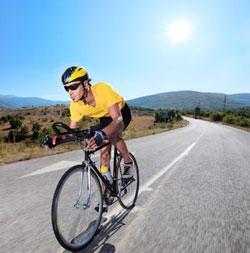Physical Therapists can Safely Cycle into the Summer with Tips for Proper Bike Fit

It never hurts to review the basics, especially when they can help patients who bike learn to prevent pain and injury, increase efficiency and eliminate discomfort. For PTs who work in physical therapy jobs that emphasize sports medicine, it’s part of the daily routine to help patients identify functional goals, i.e. endurance OR speed and performance.
Posture tips for making the most out of every bicycling work-out include these three basics: 1) Changing hand position on handlebars frequently 2) Maintaining a controlled but relaxed grip on the handlebars and 3) Understanding the importance of back strength.
These fundamentals from the APTA can help with proper bike fit:
- Trunk positioning is a crucial part of proper bike fit. The recreational rider’s trunk should be positioned **40 to 80 degrees from horizontal; the shoulder angle between 80 and 90 degrees.
- Knee to Pedal positioning is ideal when it is **as close to 35 degrees as possible. This will ensure better function, with less stress to the knee. For the recreational biker, knee to pedal angle should be 35 to 40 degrees; for the road cyclist, therapists recommend an angle of **30 to 35 degrees.
- Foot to Pedal positioning should ensure that **the ball of the foot is placed over the pedal spindle for the best leverage, comfort, and efficiency; a stiff-soled shoe is best for comfort and performance. The optimal goal of revolutions per minute when peddling is between **80 and 90.
- Handlebar positioning **affects hand, shoulder, neck, and back comfort. The higher the handlebars, the more weight will be placed on the saddle. Taller cyclists should have lower handlebars in relation to the height of the seat. Road cyclists should position their hands approximately 2 centimeters wider than the shoulders for optimal peddling, efficiency and aerodynamics.
- Seat positioning can make or break proper bike fit. **If you are sliding too far forward, that means too much weight is being placed on your hands, arms, and lower back. If the seat is tilted backwards then you may place undue strain on your lower back. The seat should also be a comfortable distance from the handlebars. If it is too close then extra weight will be placed on the mid-back and arms; too far away and extra strain will be placed on the lower back and neck.
Therapists Can Help Outfit the Bike and Cyclist: Helmets should feature tight traps to prevent slipping and bear the marking of “Snell Certified” or “Meets ANS12904 standard”. A white light on the front of the bike, red reflector or light on rear, and orange flag fastened to the back of your bike increases visibility. Softer handlebar tape and shock absorbers for the seat post and front fork are also worth inquiring about at the local bike shop!
The Right Healthcare Staffing Agency Will Ensure that You Work in An Ideal Healthcare Setting!
American Traveler Allied places our allied healthcare team in top paying therapy jobs in all 50 U.S. states. Our therapists work in diverse settings—from prestigious teaching hospitals and award winning rehab centers to outpatient clinics with sterling reputations; many of our clients are noted on U.S. News & World Report’s Best Hospitals List. Don’t stop with ensuring proper bike fit—make sure your allied healthcare career is a perfect fit as well by calling 1-800-617-0608 or applying online today!